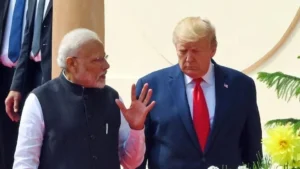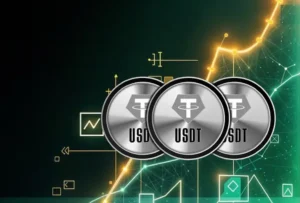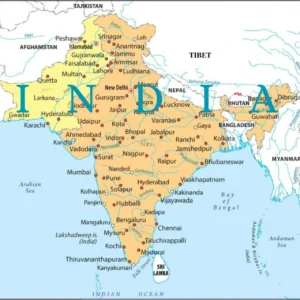Trump vs Modi: A Clash of National Priorities ‘America First’ vs. ‘India First
India-USA Relations: A Strategic Partnership or a Power Struggle?
Over the past two decades, India and USA have come closer as strategic partners, engaging in defense, trade, and technological collaboration. However, behind closed doors, Washington has repeatedly attempted to influence India’s policies, leading to a sense of distrust.
While Trump’s first term saw a strengthening of ties, his recent re-election has signaled a more aggressive stance towards India. The key question now is:
👉 Will India bow down to US pressure, or will Modi pursue an ‘India First’ policy, just as Trump prioritizes ‘America First’?
The Shift in US Attitude Towards India
India has never been a typical US ally like the UK or Japan. Instead, it has pursued strategic autonomy, maintaining good relations with both Western and Eastern powers. However, the USA often seeks to influence India’s decisions, whether in trade, defense, or foreign policy.
Some recent events highlight this:
- Higher Tariffs: After returning to power, Trump increased tariffs on Indian goods, despite previously promising to strengthen economic ties.
- US Election Interference Allegations: Trump has claimed that Biden’s administration tried to influence India’s 2024 elections, with reports suggesting $21 million in USAID funding was sent to India during the electoral process.
- Deportation of Indian Immigrants: Thousands of Indians living illegally in the USA are being handcuffed and forcibly deported, raising questions about targeted actions against Indian citizens.
These actions indicate that while the US considers India a ‘friend,’ it does not hesitate to exert pressure when needed.
Modi’s Stand: A Self-Reliant India
During his joint Press Conference with Trump, Modi made it clear that:
“Just as Trump wants to ‘Make America Great Again’ (MAGA), India has its own vision of ‘Make India Great Again’ (MIGA).”
This shows that Modi is not willing to compromise on India’s sovereignty, even if it means challenging US expectations.
1. Will India Accept the F-35 Deal?
Trump has offered F-35 fighter jets to India, but Delhi remains hesitant. The reasons?
- India already has strong defense agreements with Russia and France, making US technology less critical.
- The USA has a history of using defense deals as leverage—for example, Pakistan received billions in military aid but was later abandoned by the US.
- India wants to reduce dependency on foreign arms and is pushing for indigenous defense manufacturing.
👉 Instead of blindly accepting US offers, India is carefully evaluating its options.
2. The Tejas Mk-II Engine Delay: Is the USA Blocking India’s Defense Growth?
India’s indigenous fighter jet, Tejas Mk-II, is set to receive US-made jet engines, but the USA is delaying the transfer of technology.
- Is this a strategic move to keep India dependent on Western technology?
- Or is the USA worried that a strong India could challenge its dominance in Asia?
This delay raises serious doubts about America’s reliability as a defense partner.
US Foreign Policy: A Pattern of Betrayal?
India is well aware of how the USA has abandoned allies in the past, which is why Modi’s government remains cautious.
Some major examples:
- Afghanistan: After 20 years of military intervention, the US suddenly withdrew in 2021, leaving the country in chaos and Taliban control.
- Ukraine: The USA initially supported Ukraine against Russia, but now Trump is pushing for peace talks without Ukraine’s involvement, calling Zelensky a “dictator”.
- Pakistan: Once a key US ally, now completely sidelined, as seen with Imran Khan’s removal and political instability.
👉 If the USA can betray these nations, why should India blindly trust Washington?
India’s Alternatives: Russia & China’s Growing Influence
While the USA pressures India, Russia and China are strengthening their strategic ties with New Delhi.
Russia-Ukraine War:
- The USA tried to isolate Russia, but India continued buying discounted Russian oil, reducing the impact of US sanctions.
- China and India both maintained trade with Russia, forcing Washington to acknowledge its limitations.
Border Tensions with China:
- The 2020 Galwan Valley clashes created tensions, but Russia played a key role in de-escalation.
- Despite conflicts, India and China are strategically aligning to challenge Western dominance.
A New Global Alliance?
With growing US interference in global politics, some analysts predict the rise of a new front: Russia-India-China (RIC).
If this alliance strengthens:
- Western economic sanctions could become ineffective
- The US will face greater challenges in controlling global politics
- India will have a strong alternative to US influence
The US War Strategy: Creating Chaos for Power?
The USA follows a pattern of creating conflicts, then abandoning allies when convenient:
- Vietnam War (1955-1975): US intervention led to mass destruction, and in the end, America withdrew without achieving its goal.
- Iraq (2003-2011): After removing Saddam Hussein, the US left Iraq unstable and in civil war.
- Libya (2011-Present): The US-backed removal of Gaddafi led to chaos, terrorism, and human trafficking in Libya.
- Afghanistan: After 20 years of military intervention, the US suddenly withdrew in 2021, leaving the country in chaos and Taliban control.
👉 Is India the next target of US political manipulation?
Conclusion: Will India Bow or Stand Tall?
Trump’s “America First” policy prioritizes US dominance, but Modi’s “India First” approach aims at making India self-reliant.
Despite US pressure:
✅ India is not giving up its strategic ties with Russia
✅ India is rejecting unnecessary US defense deals
✅ India is resisting US interference in its politics
The future of India-USA relations depends on one question—will Washington respect India’s sovereignty, or will it continue its history of interference?
One thing is certain: India is no longer a nation that will bow to foreign pressure.





